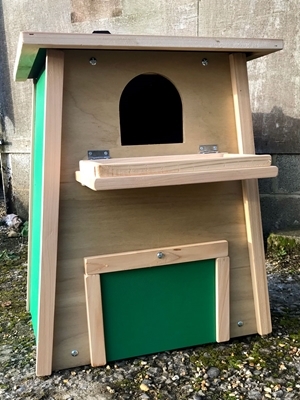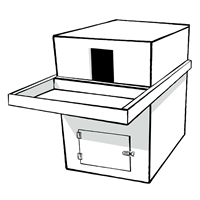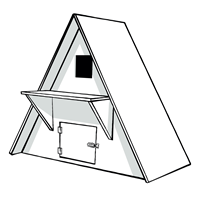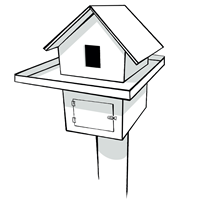 There are many manufacturers that produce barn owl nest boxes to purchase, but if materials and tools are available, then boxes can also be made by hand.
There are many manufacturers that produce barn owl nest boxes to purchase, but if materials and tools are available, then boxes can also be made by hand.
Siting your barn owl nest box in an appropriate location is very important, as well as the actual box design itself. There are five species of owl in the UK and due to differences in size, behaviour and preferred habitat, the box design and dimensions differ from species to species.
This blog will provide guidance on how to make a barn owl nest box, sharing the necessary design specifications needed to:
- Increase the likelihood of barn owls occupying the nest box
- Aid prospects of breeding success
- Increase opportunity for greater survival
Barn owl nest box requirements
 To stop young owlets being able to leave the box before they are ready, the depth of the box should be at least 45cm from the entrance hole, and the base between 50x50cm and 70x70cm. These dimensions will provide enough room for adults to provision their young as they grow and to provide enough space for multiple chicks to manoeuvre as they become stronger.
To stop young owlets being able to leave the box before they are ready, the depth of the box should be at least 45cm from the entrance hole, and the base between 50x50cm and 70x70cm. These dimensions will provide enough room for adults to provision their young as they grow and to provide enough space for multiple chicks to manoeuvre as they become stronger.
The entrance hole, seen from a distance, can encourage a barn owl to investigate a box during flight, so the hole should be large enough to be visible and fly into. Suitable dimensions for the entrance hole are between 10x10cm and 15x15cm, and an outside platform gives a perching area for young owls to stretch their wings and reduce the risk of them falling to the ground before being able to fly.
Outside boxes should be weatherproofed with a non-toxic, water-based treatment and avoid substances that are strong smelling or remain tacky after application. A well waterproofed nest box will last longer and will ensure chicks and eggs remain dry; a lip to the roof will also help to stop rain entering the entrance hole. Remember to put drainage holes in the bottom of the box to prevent its base from becoming wet.
Maintenance
When a box is housing breeding barn owls, it is illegal to disturb them, therefore maintenance checks to ensure the boxes are fit for use should be carried out through the non-breeding period of November to February.
Boxes that have been regularly occupied will have built up a dense layer of pellets over time and will slowly reduce the depth of the box (below the required minimum depth of 45cm from the entrance hole). Every few years the box should be cleaned out to keep the required depth and to provide a fresh environment for any future breeding attempts.
Maintenance of the box itself may also be required, such as re-application of wood treatments, fixing leaks and checking that the bottom of the box is secure to support the weight of growing chicks. Also, over time vegetation can obscure entrance holes of external boxes, so over the winter months it is important to prune any branches that may cover the hole when leaves are back on the trees.
Barn owl box designs
Various box designs can be made to accommodate different site locations, such as indoor barns, on isolated trees or mounted in a suitable area on a pole.
Indoor box
 This design of indoor box is usually mounted inside a building, attached to a horizontal beam in a barn. An inside box would benefit from being treated and should ideally be situated in a building with little disturbance.
This design of indoor box is usually mounted inside a building, attached to a horizontal beam in a barn. An inside box would benefit from being treated and should ideally be situated in a building with little disturbance.
See here for the Barn Owl Trust’s detailed design guide.
A-frame box
 These boxes are a commonly used nest box design for external use and are regularly used when mounting a box on a tree. If used externally they should be properly waterproofed, making sure the box roof protrudes over the entrance hole to stop rain from blowing in.
These boxes are a commonly used nest box design for external use and are regularly used when mounting a box on a tree. If used externally they should be properly waterproofed, making sure the box roof protrudes over the entrance hole to stop rain from blowing in.
Pole-mounted box
 Although not common in the UK, a nest box that is mounted on a free-standing pole can be used when there are no suitable indoor buildings or trees. This box can be made deeper due to no nearby perches for chicks to emerge onto before fledging. An exercise platform all the way around the box will provide an opportunity for chicks to stretch and strengthen their wings before they attempt their first flight.
Although not common in the UK, a nest box that is mounted on a free-standing pole can be used when there are no suitable indoor buildings or trees. This box can be made deeper due to no nearby perches for chicks to emerge onto before fledging. An exercise platform all the way around the box will provide an opportunity for chicks to stretch and strengthen their wings before they attempt their first flight.
It is also important that the pole used to mount the box is predator proof, so a smooth, rounded metal pole will provide an anti-climb surface; and as with any outside box, weatherproofing should be carried out and an overhanging roof should be provided to stop rain from blowing in.